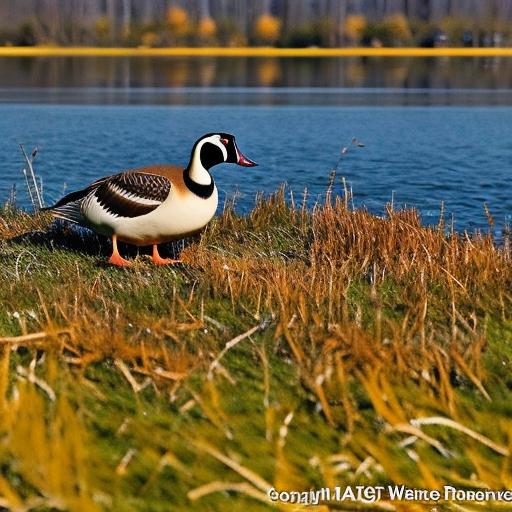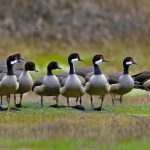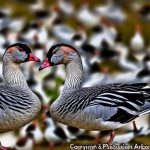Canadian geese infestation is a growing problem in many areas across Canada. These birds, known for their distinctive honking and large size, can cause significant damage to property and pose health risks to humans. Finding humane solutions to control the geese population is crucial in order to protect both the environment and the well-being of these animals. This article will explore various methods of goose control that are effective and humane.
Key Takeaways
- Canadian geese are attracted to open spaces near water and grassy areas.
- Physical barriers such as fences and netting can prevent geese from accessing certain areas.
- Visual deterrents like decoys and reflective tape can scare geese away.
- Noise-making devices like air horns and propane cannons can also deter geese.
- Scents like grape extract and peppermint oil can repel geese.
Understanding Canadian Geese Behavior
Canadian geese are native to North America and are known for their long migrations. They are attracted to areas with open water, abundant food sources, and suitable nesting sites. Understanding their behavior and migration patterns is essential in developing effective control strategies. Canadian geese typically migrate in the spring and fall, traveling in large flocks. They are attracted to areas with open water, such as lakes, ponds, and golf courses, where they can find food and nesting sites.
Implementing Physical Barriers
Physical barriers can be an effective way to deter Canadian geese from certain areas. There are several types of physical barriers that can be used, including fences, netting, and floating barriers. Fences can be used to create a physical barrier between the geese and the desired area. Netting can be installed over bodies of water to prevent geese from landing or swimming in the area. Floating barriers can be placed on the water’s surface to create an obstacle for the geese.
Each type of physical barrier has its advantages and disadvantages. Fences are a permanent solution that can effectively keep geese out of an area, but they can be expensive to install and may not be aesthetically pleasing. Netting is a cost-effective option that can be easily installed and removed, but it may require regular maintenance to prevent damage from weather or wildlife. Floating barriers are a temporary solution that can be easily moved or adjusted as needed, but they may not be as effective in deterring geese as other types of barriers.
When installing physical barriers, it is important to consider the height and strength of the barrier. Geese can fly and may attempt to jump or climb over a barrier if it is not tall enough or if there are objects nearby that they can use as a perch. It is also important to regularly inspect and maintain the barriers to ensure they remain effective.
Using Visual Deterrents
Visual deterrents can be an effective way to deter Canadian geese from certain areas. There are several types of visual deterrents that can be used, including scarecrows, reflective tape, and predator decoys. Scarecrows can be placed in areas where geese are likely to land or feed, creating a visual deterrent. Reflective tape can be hung from trees or poles, creating flashes of light that can startle and deter geese. Predator decoys, such as plastic owls or coyotes, can be placed in areas where geese are likely to gather, creating the illusion of a predator presence.
Each type of visual deterrent has its advantages and disadvantages. Scarecrows are a cost-effective option that can be easily moved or adjusted as needed, but they may not be effective in deterring geese if they become accustomed to them. Reflective tape is a low-cost option that can be easily installed and removed, but it may not be as effective in deterring geese during daylight hours. Predator decoys are a realistic option that can effectively deter geese, but they may require regular movement or repositioning to maintain their effectiveness.
When using visual deterrents, it is important to regularly inspect and maintain them to ensure they remain effective. Geese can become accustomed to visual deterrents over time, so it may be necessary to periodically change the location or appearance of the deterrents to keep them effective.
Installing Noise-Making Devices
Noise-making devices can be an effective way to deter Canadian geese from certain areas. There are several types of noise-making devices that can be used, including propane cannons, ultrasonic devices, and pyrotechnics. Propane cannons create loud noises that can startle and deter geese. Ultrasonic devices emit high-frequency sounds that are unpleasant to geese. Pyrotechnics, such as bird bangers or screamers, create loud noises and flashes of light that can scare geese away.
Each type of noise-making device has its advantages and disadvantages. Propane cannons are a powerful option that can effectively deter geese, but they may be loud and disruptive to nearby residents or wildlife. Ultrasonic devices are a quiet option that can be easily installed and adjusted, but they may not be effective in deterring geese if they become accustomed to the sound. Pyrotechnics are a versatile option that can be used in various settings, but they may require special permits or training to use safely.
When installing noise-making devices, it is important to consider the location and timing of the devices. Geese may become accustomed to the noise if it is constant or predictable, so it may be necessary to vary the timing or location of the devices to keep them effective. It is also important to follow local regulations and guidelines when using noise-making devices, as some areas may have restrictions on their use.
Employing Scents to Repel Geese

Scents can be an effective way to repel Canadian geese from certain areas. There are several types of scents that can be used, including grape extract, peppermint oil, and predator urine. Grape extract can be sprayed on grass or other surfaces to create an unpleasant scent for geese. Peppermint oil can be applied to plants or other objects to create a strong odor that geese find unpleasant. Predator urine, such as coyote or fox urine, can be sprayed around an area to create the illusion of a predator presence.
Each type of scent has its advantages and disadvantages. Grape extract is a natural option that is safe for the environment and can be easily applied, but it may need to be reapplied regularly to remain effective. Peppermint oil is a strong option that can effectively repel geese, but it may need to be reapplied regularly and can be expensive. Predator urine is a realistic option that can create an effective deterrent, but it may require regular reapplication and can be unpleasant for humans.
When using scents to repel geese, it is important to consider the location and timing of the scents. Geese may become accustomed to the scent if it is constant or predictable, so it may be necessary to vary the timing or location of the scents to keep them effective. It is also important to follow local regulations and guidelines when using scents, as some areas may have restrictions on their use.
Creating Unwelcoming Habitat for Geese
Creating an unwelcoming habitat for Canadian geese can be an effective way to deter them from certain areas. There are several tips for making an area less attractive to geese, including removing food sources, modifying the landscape, and using vegetation barriers. Removing food sources, such as grass clippings or fallen fruit, can reduce the attractiveness of an area to geese. Modifying the landscape by adding slopes or barriers can make it more difficult for geese to access certain areas. Using vegetation barriers, such as tall grasses or shrubs, can create obstacles that deter geese from landing or feeding in an area.
Examples of changes that can be made to the environment include installing fences or netting around bodies of water, planting tall grasses or shrubs along shorelines, and removing excess vegetation or debris from an area. These changes can make an area less attractive to geese and reduce the likelihood of them nesting or feeding in the area.
Utilizing Motion-Activated Sprinklers
Motion-activated sprinklers can be an effective way to deter Canadian geese from certain areas. These devices use motion sensors to detect the presence of geese and automatically activate a sprinkler system, creating a sudden burst of water that startles and deters the geese. Motion-activated sprinklers are a humane option that does not harm the geese but effectively discourages them from entering an area.
The advantages of motion-activated sprinklers include their effectiveness in deterring geese, their ease of installation, and their low maintenance requirements. Motion-activated sprinklers can be easily installed in areas where geese are likely to gather, such as lawns or gardens. They require minimal maintenance, as they are self-activating and do not require regular refilling or repositioning.
When using motion-activated sprinklers, it is important to consider the location and timing of the devices. Geese may become accustomed to the sprinklers if they are constantly activated or if they are predictable in their timing. It may be necessary to vary the location or timing of the sprinklers to keep them effective. It is also important to regularly inspect and maintain the sprinklers to ensure they remain in working order.
Seeking Professional Help
In some cases, it may be necessary to seek professional help for goose control. This is especially true if other methods have been unsuccessful or if the infestation is severe. There are several types of professionals who can assist with goose control, including wildlife removal specialists, pest control companies, and landscape professionals.
When considering hiring a professional for goose control, it is important to ask questions about their experience and methods. Some key questions to ask include:
– What methods do you use for goose control?
– Are your methods humane and environmentally friendly?
– How long have you been in business?
– Can you provide references from previous clients?
– What is the cost of your services?
– Do you offer any guarantees or warranties?
It is also important to check the credentials and reputation of any professional before hiring them. This can be done by checking online reviews, asking for references, or contacting local wildlife or pest control agencies for recommendations.
Adopting Humane Methods of Goose Control
Using humane methods of goose control is important for both ethical and practical reasons. Humane methods prioritize the well-being of the geese while still effectively deterring them from certain areas. Examples of humane methods include using visual deterrents, noise-making devices, scents, and creating an unwelcoming habitat.
Humane methods of goose control are not only more ethical, but they are also more sustainable in the long term. By focusing on deterring geese rather than harming or killing them, it is possible to maintain a balance between human needs and wildlife conservation. This approach also reduces the risk of negative impacts on other species or the environment.
Maintaining a Consistent Prevention Strategy
Maintaining a consistent prevention strategy is crucial in effectively controlling Canadian geese populations. Geese are intelligent animals and can quickly adapt to new deterrents or overcome obstacles. By consistently implementing and maintaining deterrents, it is possible to discourage geese from returning to certain areas.
Consistency in prevention efforts involves regularly inspecting and maintaining physical barriers, visual deterrents, noise-making devices, scents, and other deterrents. It may also involve periodically changing the location or appearance of deterrents to prevent geese from becoming accustomed to them. Regular monitoring of geese activity and adjusting prevention strategies as needed can help ensure long-term success in controlling geese populations.
Canadian geese infestation is a problem that requires effective and humane solutions. Understanding geese behavior, implementing physical barriers, using visual deterrents, installing noise-making devices, employing scents, creating an unwelcoming habitat, utilizing motion-activated sprinklers, seeking professional help when necessary, adopting humane methods, and maintaining a consistent prevention strategy are all important steps in controlling geese populations. By taking action in a humane and effective way, it is possible to protect both the environment and the well-being of these animals.
If you’re looking for effective ways to keep Canadian geese off your property, you might find this article on poultrywizard.com helpful. They provide valuable insights and tips on various aspects of poultry keeping, including chicken coop run plans (source) and turning a shed into a chicken coop (source). While these articles focus on chickens, the principles and strategies discussed can be adapted to deter geese as well. Additionally, if you’re interested in breeding ducks and want to understand more about duck mating season, poultrywizard.com offers an informative article on the topic (source).
FAQs
What are Canadian geese?
Canadian geese are a species of waterfowl that are native to North America. They are known for their distinctive black heads and necks, white cheeks, and brown bodies.
Why do Canadian geese come onto my property?
Canadian geese are attracted to areas with open water, grassy areas, and low-lying vegetation. They may come onto your property to feed, rest, or nest.
Are Canadian geese protected by law?
Yes, Canadian geese are protected under the Migratory Bird Treaty Act, which makes it illegal to harm, capture, or kill them without a permit.
What are the risks of having Canadian geese on my property?
Canadian geese can cause damage to property, leave behind droppings that can be unsanitary and attract other pests, and pose a risk to human health due to the potential spread of diseases.
How can I keep Canadian geese off my property?
There are several methods for keeping Canadian geese off your property, including using visual deterrents, installing physical barriers, and modifying the landscape to make it less attractive to geese.
What are some visual deterrents for Canadian geese?
Visual deterrents for Canadian geese include scarecrows, reflective tape, balloons, and predator decoys.
What are some physical barriers for Canadian geese?
Physical barriers for Canadian geese include fences, netting, and hedges.
How can I modify my landscape to make it less attractive to Canadian geese?
Modifications to your landscape that can make it less attractive to Canadian geese include removing open water sources, reducing the amount of low-lying vegetation, and using landscaping materials that are less attractive to geese.
Meet Walter, the feathered-friend fanatic of Florida! Nestled in the sunshine state, Walter struts through life with his feathered companions, clucking his way to happiness. With a coop that’s fancier than a five-star hotel, he’s the Don Juan of the chicken world. When he’s not teaching his hens to do the cha-cha, you’ll find him in a heated debate with his prized rooster, Sir Clucks-a-Lot. Walter’s poultry passion is no yolk; he’s the sunny-side-up guy you never knew you needed in your flock of friends!







